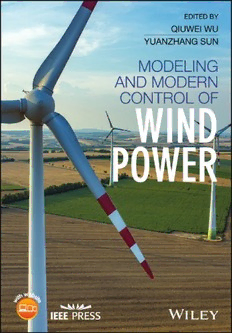Table Of ContentModelingandModernControlofWindPower
Modeling and Modern Control of Wind Power
Editedby
QiuweiWu
TechnicalUniversityofDenmark,Kgs.Lyngby,Denmark
YuanzhangSun
WuhanUniversity,China
Thiseditionfirstpublished2018
©2018JohnWiley&SonsLtd
Allrightsreserved.Nopartofthispublicationmaybereproduced,storedinaretrievalsystem,or
transmitted,inanyformorbyanymeans,electronic,mechanical,photocopying,recordingorotherwise,
exceptaspermittedbylaw.Adviceonhowtoobtainpermissiontoreusematerialfromthistitleisavailable
athttp://www.wiley.com/go/permissions.
TherightofQiuweiWuandYuanzhangSuntobeidentifiedastheauthorsoftheeditorialmaterialinthis
workhasbeenassertedinaccordancewithlaw.
RegisteredOffice(s)
JohnWiley&Sons,Inc.,111RiverStreet,Hoboken,NJ07030,USA
JohnWiley&SonsLtd,TheAtrium,SouthernGate,Chichester,WestSussex,PO198SQ,UK
EditorialOffice
TheAtrium,SouthernGate,Chichester,WestSussex,PO198SQ,UK
Fordetailsofourglobaleditorialoffices,customerservices,andmoreinformationaboutWileyproducts
visitusatwww.wiley.com.
Wileyalsopublishesitsbooksinavarietyofelectronicformatsandbyprint-on-demand.Somecontentthat
appearsinstandardprintversionsofthisbookmaynotbeavailableinotherformats.
LimitofLiability/DisclaimerofWarranty
Whilethepublisherandauthorshaveusedtheirbesteffortsinpreparingthiswork,theymakeno
representationsorwarrantieswithrespecttotheaccuracyorcompletenessofthecontentsofthisworkand
specificallydisclaimallwarranties,includingwithoutlimitationanyimpliedwarrantiesofmerchantabilityor
fitnessforaparticularpurpose.Nowarrantymaybecreatedorextendedbysalesrepresentatives,written
salesmaterialsorpromotionalstatementsforthiswork.Thefactthatanorganization,website,orproductis
referredtointhisworkasacitationand/orpotentialsourceoffurtherinformationdoesnotmeanthatthe
publisherandauthorsendorsetheinformationorservicestheorganization,website,orproductmayprovide
orrecommendationsitmaymake.Thisworkissoldwiththeunderstandingthatthepublisherisnotengaged
inrenderingprofessionalservices.Theadviceandstrategiescontainedhereinmaynotbesuitableforyour
situation.Youshouldconsultwithaspecialistwhereappropriate.Further,readersshouldbeawarethat
websiteslistedinthisworkmayhavechangedordisappearedbetweenwhenthisworkwaswrittenandwhen
itisread.Neitherthepublishernorauthorsshallbeliableforanylossofprofitoranyothercommercial
damages,includingbutnotlimitedtospecial,incidental,consequential,orotherdamages.
LibraryofCongressCataloging-in-PublicationData:
Names:Wu,Qiuwei,editor.|Sun,Yuanzhang,1954-editor.
Title:Modelingandmoderncontrolofwindpower/editedbyQiuweiWu,
YuanzhangSun.
Description:Hoboken,NJ:JohnWiley&Sons,2018.|Includes
bibliographicalreferencesandindex.|
Identifiers:LCCN2017030336(print)|LCCN2017043924(ebook)|ISBN
9781119236405(pdf)|ISBN9781119236399(epub)|ISBN9781119236269
(cloth)
Subjects:LCSH:Windpower–Mathematicalmodels.|Windpowerplants.|Wind
turbines.
Classification:LCCTJ820(ebook)|LCCTJ820.M632017(print)|DDC
621.31/2136–dc23
LCrecordavailableathttps://lccn.loc.gov/2017030336
CoverDesign:Wiley
CoverImage:©Stockr/Shutterstock
Setin10/12ptWarnockbySPiGlobal,Chennai,India
10 9 8 7 6 5 4 3 2 1
v
Contents
ListofContributors xi
AbouttheCompanionWebsite xiii
1 StatusofWindPowerTechnologies 1
HaoranZhaoandQiuweiWu
1.1 WindPowerDevelopment 1
1.2 WindTurbineGeneratorTechnology 4
1.2.1 Type1 4
1.2.2 Type2 5
1.2.3 Type3 5
1.2.4 Type4 6
1.2.5 Comparison 7
1.2.6 ChallengeswithWindPowerIntegration 7
1.3 Conclusion 9
References 9
2 GridCodeRequirementsforWindPowerIntegration 11
QiuweiWu
2.1 Introduction 11
2.2 Steady-stateOperationalRequirements 12
2.2.1 ReactivePowerandPowerFactorRequirements 12
2.2.2 ContinuousVoltageOperatingRange 17
2.2.3 FrequencyOperatingRangeandFrequencyResponse 18
2.2.4 PowerQuality 24
2.3 Low-voltageRideThroughRequirement 26
2.3.1 LVRTRequirementintheUK 26
2.3.2 LVRTRequirementinIreland 29
2.3.3 LVRTRequirementinGermany(TennetTSOGmbH) 30
2.3.4 LVRTRequirementinDenmark 31
2.3.5 LVRTRequirementinSpain 31
2.3.6 LVRTRequirementinSweden 32
2.3.7 LVRTRequirementintheUSA 33
2.3.8 LVRTRequirementinQuebecandAlberta 34
2.4 Conclusion 36
References 36
vi Contents
3 ControlofDoubly-fedInductionGeneratorsforWindTurbines 37
GuojieLiandLijunHang
3.1 Introduction 37
3.2 PrinciplesofDoubly-fedInductionGenerator 37
3.3 PQControlofDoubly-fedInductionGenerator 40
3.3.1 Grid-sideConverter 41
3.3.2 Rotor-sideconverter 43
3.4 DirectTorqueControlofDoubly-fedInductionGenerators 46
3.4.1 FeaturesofDirectTorqueControl 47
3.4.2 ApplicationofDirectTorqueControlinDFIGs 49
3.4.3 PrincipleofDirectTorqueControlinDFIG 50
3.5 Low-voltageRideThroughofDFIGs 58
3.6 Conclusions 61
References 61
4 OptimalControlStrategiesofWindTurbinesforLoadReduction 63
ShujuHuandBinSong
4.1 Introduction 63
4.2 TheDynamicModelofaWindTurbine 64
4.2.1 WindConditionsModel 64
4.2.2 AerodynamicModel 64
4.2.3 TowerModel 66
4.2.4 DrivetrainModel 66
4.2.5 ElectricalControlModel 67
4.2.6 WindTurbineDynamicModel 67
4.3 WindTurbineIndividualPitchControl 67
4.3.1 ControlImplementation 68
4.3.2 LinearizationoftheWindTurbineModel 68
4.3.3 ControllerDesign 71
4.3.4 SimulationAnalysis 73
4.4 DrivetrainTorsionalVibrationControl 73
4.4.1 LQGControllerDesign 73
4.4.2 SimulationAnalysis 79
4.5 Conclusion 83
References 83
5 ModelingofFull-scaleConverterWindTurbineGenerator 85
YongningChi,ChaoLiu,XinshouTian,LeiShi,andHaiyanTang
5.1 Introduction 85
5.2 OperatingCharacteristicsofFSC-WTGs 88
5.3 FSC-WTGModel 89
5.3.1 ShaftModel 89
5.3.2 GeneratorModel 91
5.3.3 Full-scaleConverterModel 94
5.4 FullScaleConverterControlSystem 96
5.4.1 ControlSystemofGenerator-sideConverter 97
5.4.2 Grid-sideConverterControlSystem 101
Contents vii
5.5 Grid-connectedFSC-WTGStabilityControl 107
5.5.1 TransientVoltageControlofGrid-sideConverter 108
5.5.2 AdditionalDCVoltageCouplingController 108
5.5.3 Simulations 109
5.6 Conclusion 114
References 114
6 Clustering-basedWindTurbineGeneratorModelLinearization 117
HaoranZhaoandQiuweiWu
6.1 Introduction 117
6.2 OperationalRegionsofPower-controlledWindTurbines 118
6.3 SimplifiedWindTurbineModel 119
6.3.1 Aerodynamics 119
6.3.2 Drivetrain 120
6.3.3 Generator 120
6.3.4 Tower 121
6.3.5 PitchActuator 121
6.4 Clustering-basedIdentificationMethod 122
6.5 Discrete-timePWAModelingofWindTurbines 123
6.5.1 IdentificationofAerodynamicTorqueT 123
a
6.5.2 IdentificationofGeneratorTorqueT 123
g
6.5.3 IdentificationofThrustForceF 124
t
6.5.4 IdentificationofCorrectionFactorK 125
c
6.5.5 FormulationofA′ andB′ 126
d d
6.5.6 RegionConstructionthroughIntersection 126
6.5.7 PWAModelofaWindTurbine 126
6.6 CaseStudy 127
6.6.1 LowWindSpeedCase 128
6.6.2 HighWindSpeedCase 129
6.7 Conclusion 131
References 131
7 AdaptiveControlofWindTurbinesforMaximumPowerPoint
Tracking 133
HaoranZhaoandQiuweiWu
7.1 Introduction 133
7.1.1 Hill-climbingSearchControl 134
7.1.2 PowerSignalFeedbackControl 135
7.1.3 Tip-speedRatioControl 135
7.2 GeneratorControlSystemforWECSs 135
7.2.1 SpeedReferenceCalculation 136
7.2.2 GeneratorTorqueControl 138
7.2.3 SpeedControl 139
7.3 Designof AdaptiveController 140
1
7.3.1 ProblemFormulation 140
7.3.2 Architectureofthe AdaptiveController 140
1
7.3.3 Closed-loopReferenceSystem 142
viii Contents
7.3.4 Designof AdaptiveControllerParameters 142
1
7.4 CaseStudy 144
7.4.1 WindSpeedEstimation 144
7.4.2 MPPTPerformance 144
7.5 Conclusion 147
References 148
8 DistributedModelPredictiveActivePowerControlofWind
Farms 151
HaoranZhaoandQiuweiWu
8.1 Introduction 151
8.2 WindFarmwithoutEnergyStorage 152
8.2.1 WindFarmControlStructure 152
8.2.2 LoadEvaluationoftheWindTurbine 154
8.2.3 MPCProblemFormulation 154
8.2.4 StandardQPProblem 156
8.2.5 ParallelGeneralizedFastDualGradientMethod 158
8.3 WindFarmEquippedwithEnergyStorage 160
8.3.1 WindFarmControlStructure 160
8.3.2 ModellingofESSUnit 161
8.3.3 MPCProblemFormulation 162
8.4 CaseStudy 163
8.4.1 WindFarmControlbasedonD-MPCwithoutESS 163
8.4.2 WindFarmControlbasedonD-MPCwithESS 166
8.5 Conclusion 171
References 172
9 ModelPredictiveVoltageControlofWindPowerPlants 175
HaoranZhaoandQiuweiWu
9.1 Introduction 175
9.2 MPC-basedWFVC 176
9.3 SensitivityCoefficientCalculation 178
9.3.1 VoltageSensitivitytoReactivePower 178
9.3.2 VoltageSensitivitytoTapPosition 179
9.4 ModelingofWTGsandSVCs/SVGs 180
9.4.1 WTGModeling 180
9.4.2 SVC/SVGModeling 181
9.4.3 GeneralCompositeModel 182
9.5 CoordinationwithOLTC 183
9.6 FormulationofMPCProblemforWFVC 184
9.6.1 CorrectiveVoltageControlMode 184
9.6.2 PreventiveVoltageControlMode 186
9.7 CaseStudy 186
9.7.1 Scenario1:NormalOperation 187
9.7.2 Scenario2:OperationwithDisturbances 187
9.8 Conclusion 190
References 191

